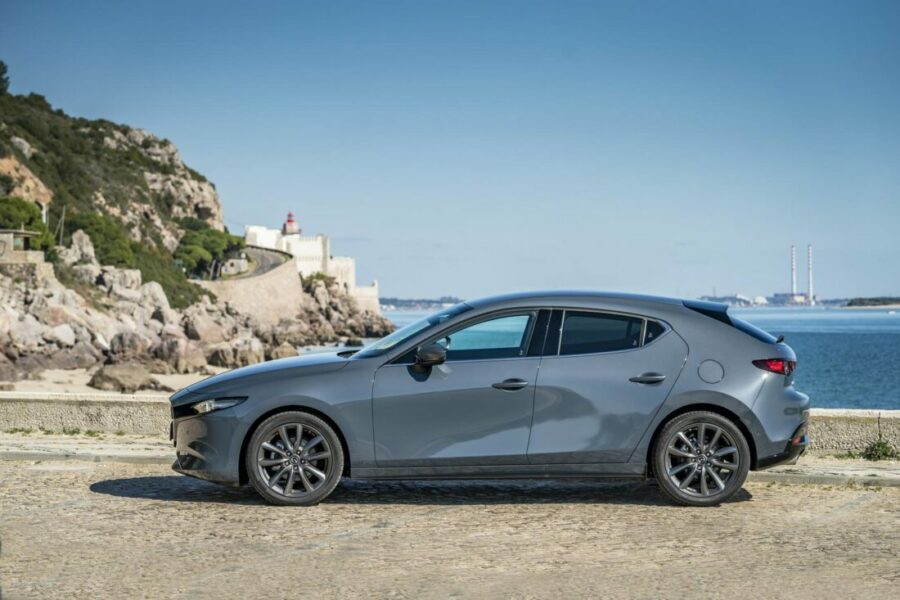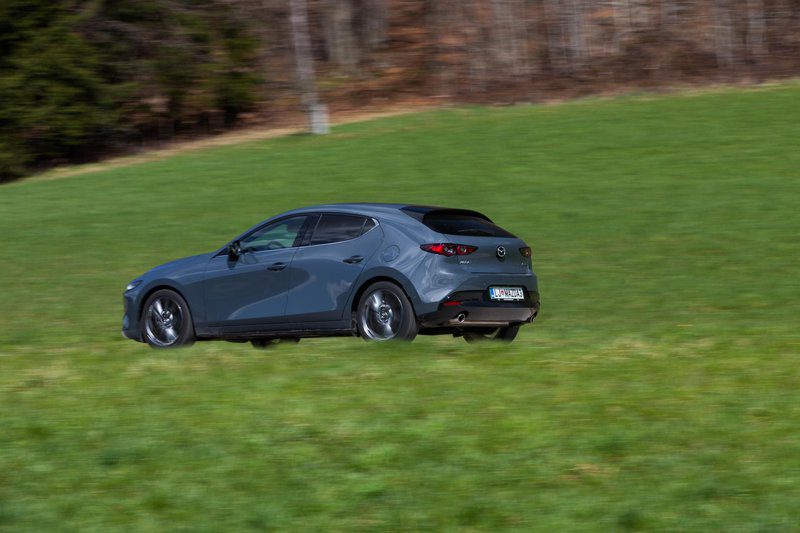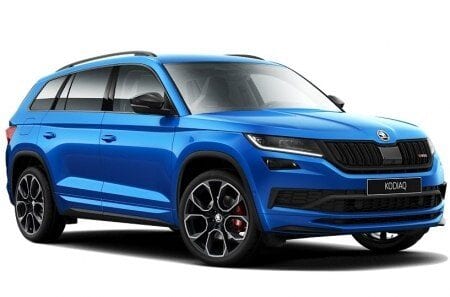
Test: Mazda3 Skyactiv-G 122 GT Plus // Trojka četrtič
Content
Well, the look is really unusual! The design approach at Mazda is denoted by the Japanese word Kodo. Shape without any additions, edges, convex or otherwise interrupted surfaces. In fact, it’s the complete opposite of what you can get from some other Japanese competitors. Of course, the shape is considered to be pleasant for some and not for others. In any case, the huge front grille and completely rounded rear add the adjective 'unusual'. So, as is the case with appearance, Mazda's approach to engine construction can also be described as at least unusual. In fact, it is against the trend in the automotive industry. The basic petrol engine is not a three-liter three-cylinder as in almost all competitors, but a two-liter four-cylinder with a rather modest capacity - for engines of such a large volume.
For later, Mazda promises a new more powerful and revolutionary with the label Skyactiv-X, which will combine the basics of operation of two motor approaches, Otto and Diesel. But in the 'troika', which is currently coming to the Slovenian market, only the most persistent fans of turbodiesels will find an alternative to petrol. The petrol version has a label G122, is renovated and equipped with a hybrid technique, but of course it is mild hybrid. But for the operation of the support system with an electric motor, Mazda has introduced an additional circuit with 24 volts.

This measure seems to be very beneficial to the well-being of the passengers in the cabin since we hardly hear the gasoline engine in the cabin (except for cold start). Even more, the overhaul of the engine contributed to the fact that the start-up of the start-stop system is almost imperceptible. The engine is definitely a more convincing part of the new Mazda3, also because it proves that even a bigger engine can be economical enough and competes on a par with the half-smaller ones.
Just as we can write for the exterior that it is unusually simple, the same design approach continues in the passenger compartment. In any case, from the first acquaintance, it provides a very good impression of the quality of the materials used and the excellent workmanship. In sunny weather, the longitudinal chrome slats are slightly disturbed, where the sun's rays can also reflect unpleasantly. But the whole impression of a very serious and almost premium approach (as Saša Kapetanovič wrote in the report from the first run, in AM 4, 2019) cannot be spoiled. The ergonomics and the offered seats in the front also make a very good impression.

We are a little more surprised, of course, if we are looking for a car that would offer enough space to those who sit on the back bench. For a car as long as it is Mazda3 (longer than almost all competitors), there is unusually little space on the back bench. This is where all the consequences of an unusual approach to car design and design can be seen. All of Mazda's extra length is 'hidden' in the long front and bonnet. Entry to the rear bench could also be easier, and the wide rear pillar gives rear passengers the impression of sitting in a sports coupe.
We have been convinced many times that Mazda is very unique when it comes to accessing the infotainment system, and in all their previous models it was considered very outdated, as a kind of consequence of the old days when models began to be designed. But the infotainment system in the new trio has shown that Mazda also looks at this part of the car offer quite differently than usual. Therefore, in the fourth generation of the trio, you will search in vain for a touch screen. A new digital technique has been used for the center classic gauges, but more than three lines of information in it cannot be adjusted by the driver.
You can get some more information about the ride and selected contents in the standard built-in projection screen on the windshield. The sleek, very wide and narrow eight-inch infotainment screen is also in a convenient place, and the driver has almost no need to look away from the road to look at it, as it is mounted high in the middle of the dashboard. But the supporters of the finger control on the screen will be very disappointed, Mazda's engineers have abolished the 'fingering' with the fingers, which in the previous model was only possible when the car was stationary.
All menus are now operated via the rotary knob on the center console next to the gear lever. Walks through the menus are more logical than before. Even in the basic version, a navigation system is available, but this does not change the fact that Mazda's infotainment system will seem outdated to many (although it is true that searching with your fingers on the screen affects poor concentration while driving). However, the connection to smartphones is now convenient and efficient.
In addition to the already mentioned basic petrol engine, this one. In the tested model, it was connected to the front drive wheels with a six-speed manual transmission. This one looks extremely precise and nicely flowing, actually reminiscent of Mazda’s on the MX-5. This combination is basic, but also almost ideal for a triple, unless of course the driver is looking for performance extremes. Since the chassis has so far been considered a better part of the car in the Mazda3, it is logical that this also applies to the successor.

Our tested car was equipped with 19-inch winter tires, so the real impression of how it behaves on the roads in the warmer part of the year cannot be written down. If it is true that winter tires are usually slightly softer than summer tires, the comfort of such large wheels on Slovenian potholed roads may suffer a little more than in our test. It was just on the verge of acceptable (especially on larger potholes), but the praise goes to a very good position on the road. The Mazda3 ranks among the leaders in its class here.
At the presentation of the renewed six, Slovenian Mazda decided to offer customers only even better-equipped versions. Thus, the new trio is already richly equipped in the basic version (without the label). Not just with the usual things that improve the well-being of the driver and passengers. The level of electronic assistants is also quite high. There’s also active cruise control and a lane-keeping restraint (at Mazda, some of these assistants are called i-Active sense).
The electronics help, but they also interfere quite actively in the driver's business (especially in cruise control), so sometimes it gets on your nerves. But the off button on the left under the dashboard helps us to test the car's sportiness on a less busy corner of the road. Noteworthy are the headlights with automatic switching and technique LED (optional on the GT Plus version) that work very satisfactorily and illuminate the road in front of the car well.
The new Mazda trio is now available in the fourth edition. Modified enough to be an interesting offer. It is interesting because in some respects it is quite unique, sometimes it even contradicts the established movements in the automotive world. Of course, this difference will also attract many customers, because it has been on the market since 2004 and out of six million customers, it has already been chosen by million Europeans.
Mazda3 Skyactiv-G 122 GT Plus
Basic data
| Sales: | Mazda Motor Slovenia Ltd. |
|---|---|
| Test model cost: | 25.740 € |
| Base model price with discounts: | 25.290 € |
| Test model price discount: | 25.740 € |
| Power: | 90kW (122 KM) |
| Acceleration (0-100 km / h): | 11.0 with |
| Maximum speed: | 197 km / h |
| Guarantee: | 5 year or 150.000 km general warranty, 12 year rust warranty, 3-year paint warranty |
| Systematic review | 20.000 km / 12 months |
Cost (up to 100.000 km or five years)
| Regular services, works, materials: | 1.187 € |
|---|---|
| Fuel: | 7.422 € |
| Tires (1) | 1.268 € |
| Loss of value (within 5 years): | 9.123 € |
| Compulsory insurance: | 2.675 € |
| CASCO INSURANCE (+ B, K), AO, AO + | 4.220 ( |
| Calculate the cost of auto insurance | |
| Buy up | € 25.895 0,26 (km cost: XNUMX €) |
Technical information
| engine: | 4-cylinder - 4-stroke - in-line - petrol - front transverse - bore and stroke 83,5 × 91,2 mm - displacement 1.998 cm3 - compression 13,0 : 1 - maximum power 90 kW (122 hp) at 6.000 /min - average piston speed at maximum power 18,2 m/s - specific power 45,0 kW/l (61,3 HP/l) - maximum torque 213 Nm at 4.000/min - 2 camshafts in the head (belt) – 4 valves per cylinder – direct fuel injection |
|---|---|
| Energy transfer: | engine powered front wheels - 6-speed manual transmission - gear ratios I. 3,363; II. 1,947 Hours; III. 1,300 Hours; IV. 1,029 Hours; V. 0,837; VI. 0,680 - differential 3,850 - 7,0 J × 18 wheels - 215/45 R 18 V tires, rolling circumference 1,96 m |
| Capacity: | top speed 197 km/h - 0-100 km/h acceleration in 10,4 s - average fuel consumption (ECE) 5,2 l/100 km, CO2 emissions 119 g/km |
| Transportation and suspension: | limo - 5 doors, 5 seats - self-supporting body - single wishbone front, coil springs, three-spoke wishbones, stabilizer - rear multi-link axle, coil springs, stabilizer - front disc brakes (forced-cooled), rear discs, ABS, electric parking brake rear wheels (switch between seats) - steering wheel with rack and pinion, electric power steering, 2,9 turns between extreme points |
| Mass: | empty vehicle 1.274 kg - permissible total weight 1.875 kg - permissible trailer weight with brake: 1.300 kg, without brake: 600 kg - permissible roof load: 75 kg. |
| External dimensions: | length 4.460 mm - width 1.795 mm, with mirrors 2.028 mm - height 1.435 mm - wheelbase 2.725 mm - front track 1.570 mm - rear 1.580 mm - ride circle 11,38 m |
| Inner dimensions: | longitudinal front 870-1.110 mm, rear 580-830 mm - front width 1.450 mm, rear 1.430 mm - head height front 900-970 mm, rear 910 mm - front seat length 500 mm, rear seat 440 mm - steering wheel ring diameter 370 mm - fuel tank 51 l |
| Box: | 358-1.026 l |
Our measurements
| T = 7 ° C / p = 1.028 mbar / rel. vl. = 57% / Tires: Goodyear Ultragrip 215/45 R 18 V / Odometer status: 3.755 km | |
| Acceleration 0-100km: | 11,0s |
|---|---|
| 402m from the city: | 17,6 years ( 130 km / h) |
| Flexibility 50-90km / h: | 9,7 / 15,8s (IV/V) |
| Flexibility 80-120km / h: | 12,3 / 20,2s (Sun./Fri.) |
| Maximum speed: | 197km / h |
| Fuel consumption according to the standard scheme: | 5,9 l / 100km |
| Braking distance at 130 km / h: | 70,4m |
| Braking distance at 100 km / h: | 42,3m |
| AM table: | 40m |
| Noise at 90 km / h in 6rd gear | 60dB |
| Noise at 130 km / h in 6rd gear | 64dB |
| Test errors: | Unmistakable |
Overall rating (450/600)
Mazda's 'troika' is in many ways a step forward from its previous generation, but it does not stand out in terms of digitalisation
Cab and trunk (84/110)
The good appearance and also the relatively large length of the car are not related to the abundant spaciousness, and the aesthetics of the cabin and usability are exemplary.
Comfort (82
/ 115)Large wheels do not contribute to the best feeling of a comfortable ride, but excellent noise insulation from under the bonnet or chassis stands out
Transmission (60
/ 80)The two-liter petrol engine without turbo assistance is special, with quite a few positive effects on the car's behavior
Driving performance (82
/ 100)A good position on the road is already a constant at Mazda
Security (85/115)
We can expect a good result in the Euro NCAP crash test, which has not yet been passed or published, and a few less assistance assistants offer a little less satisfaction with the feeling of safety.
Economy and environment (57
/ 80)Moderate fuel consumption and a fairly attractive price for the basic model will convince many customers
Driving pleasure: 3/5
Even a hard and uncomfortable suspension does not spoil the good feeling in fast corners. Engine performance is still on the verge of satisfactory
We praise and reproach
sense of quality of materials and workmanship, cabin insulation
interesting shape
fairly rich basic equipment
position on the road
spaciousness in the rear seats
above-average length for a class that doesn’t feel in better spaciousness
a different approach to the management of the infotainment system
